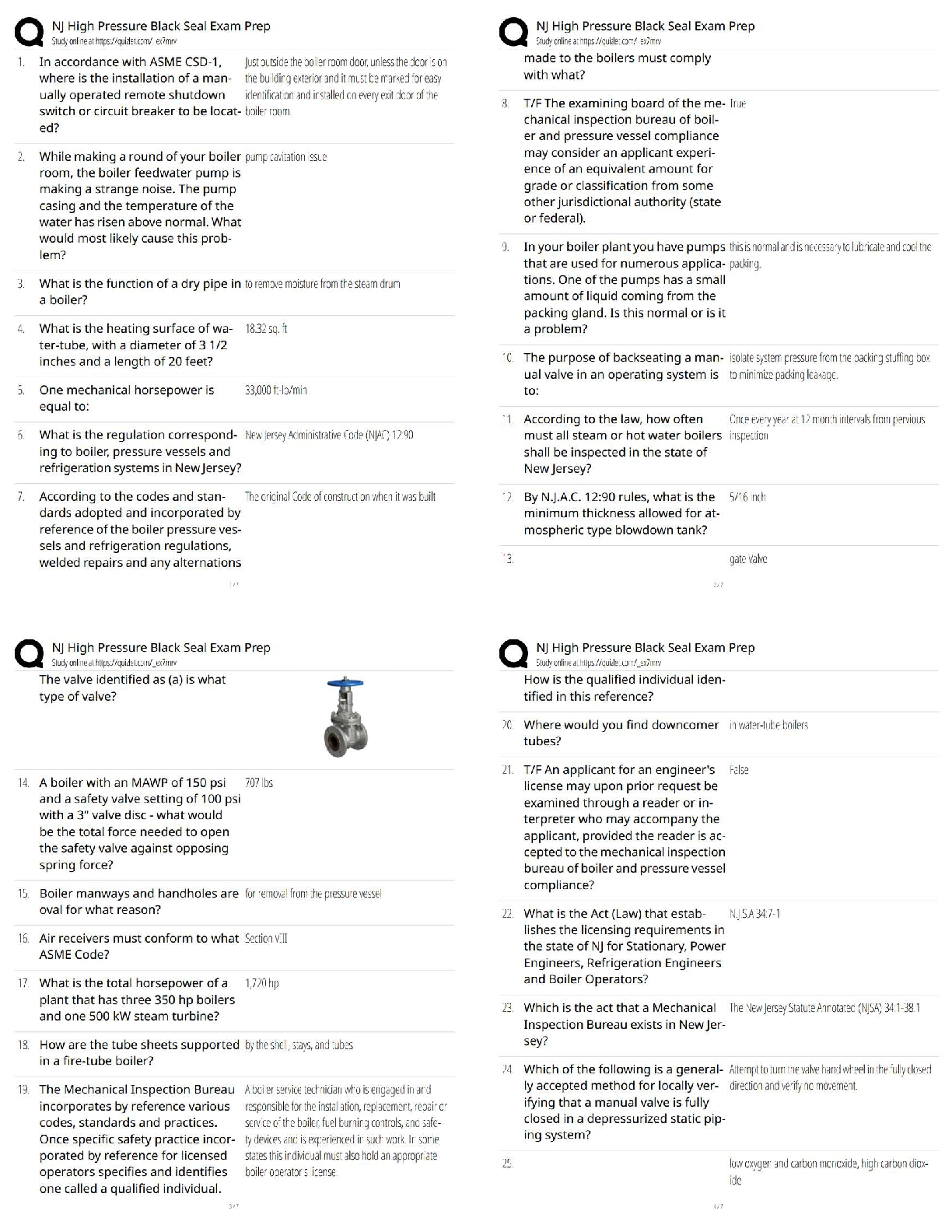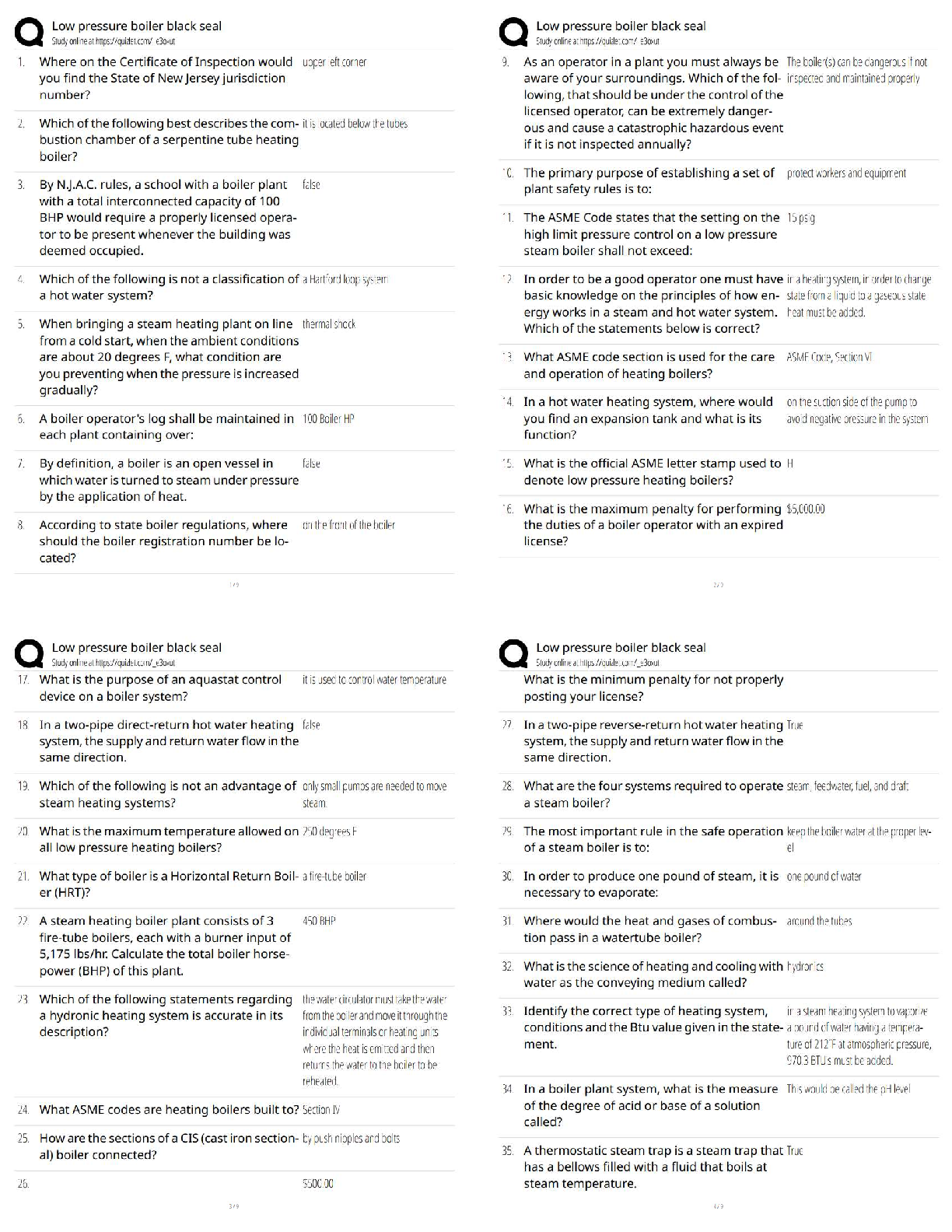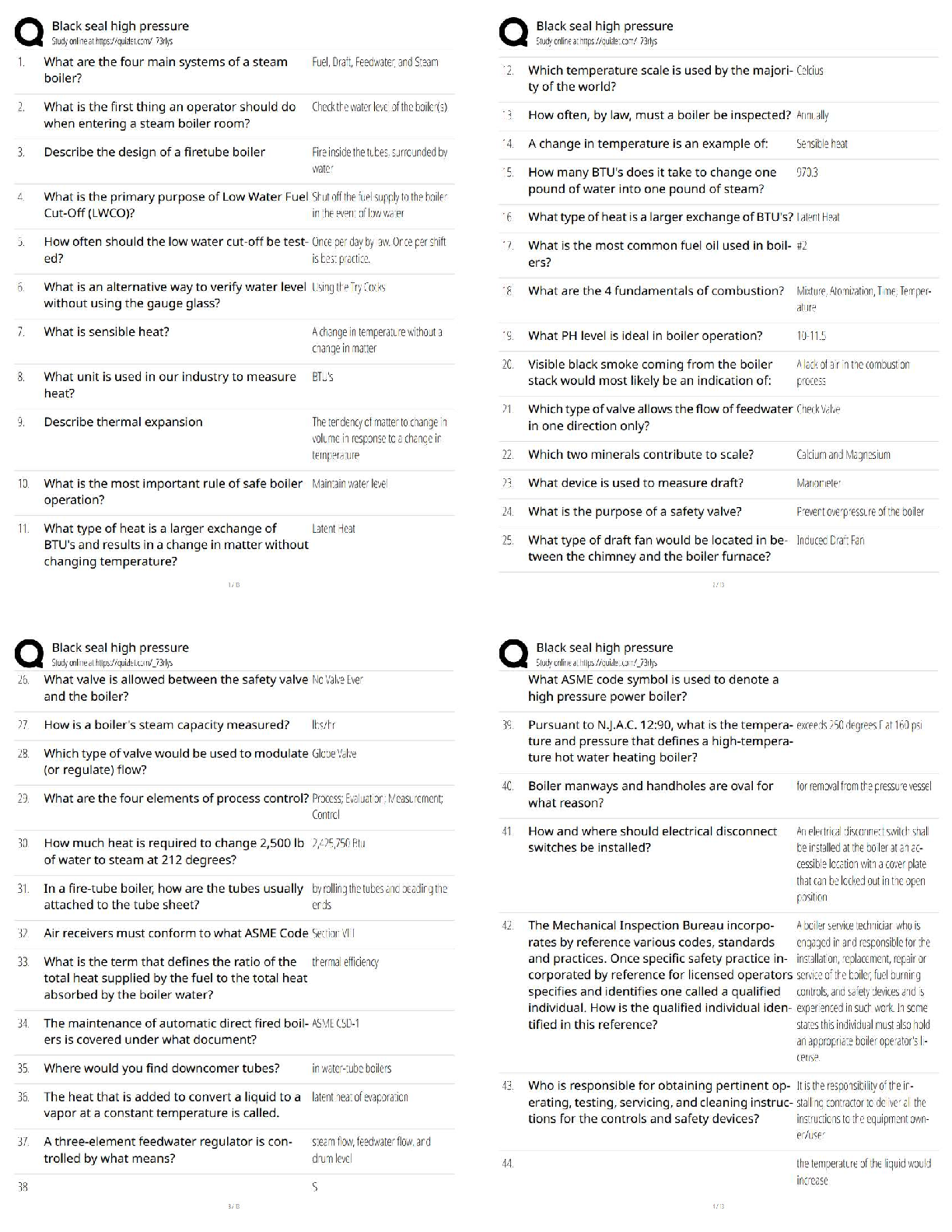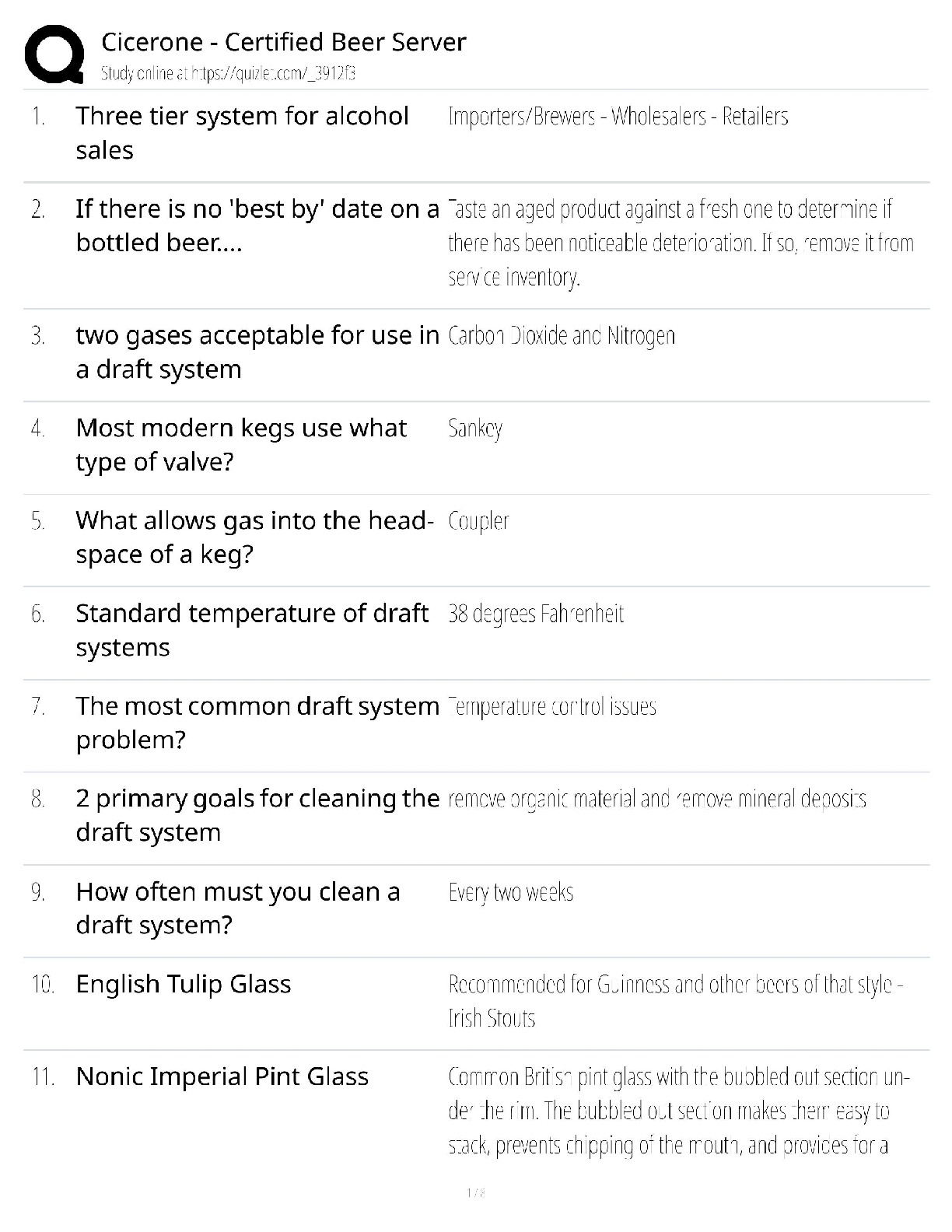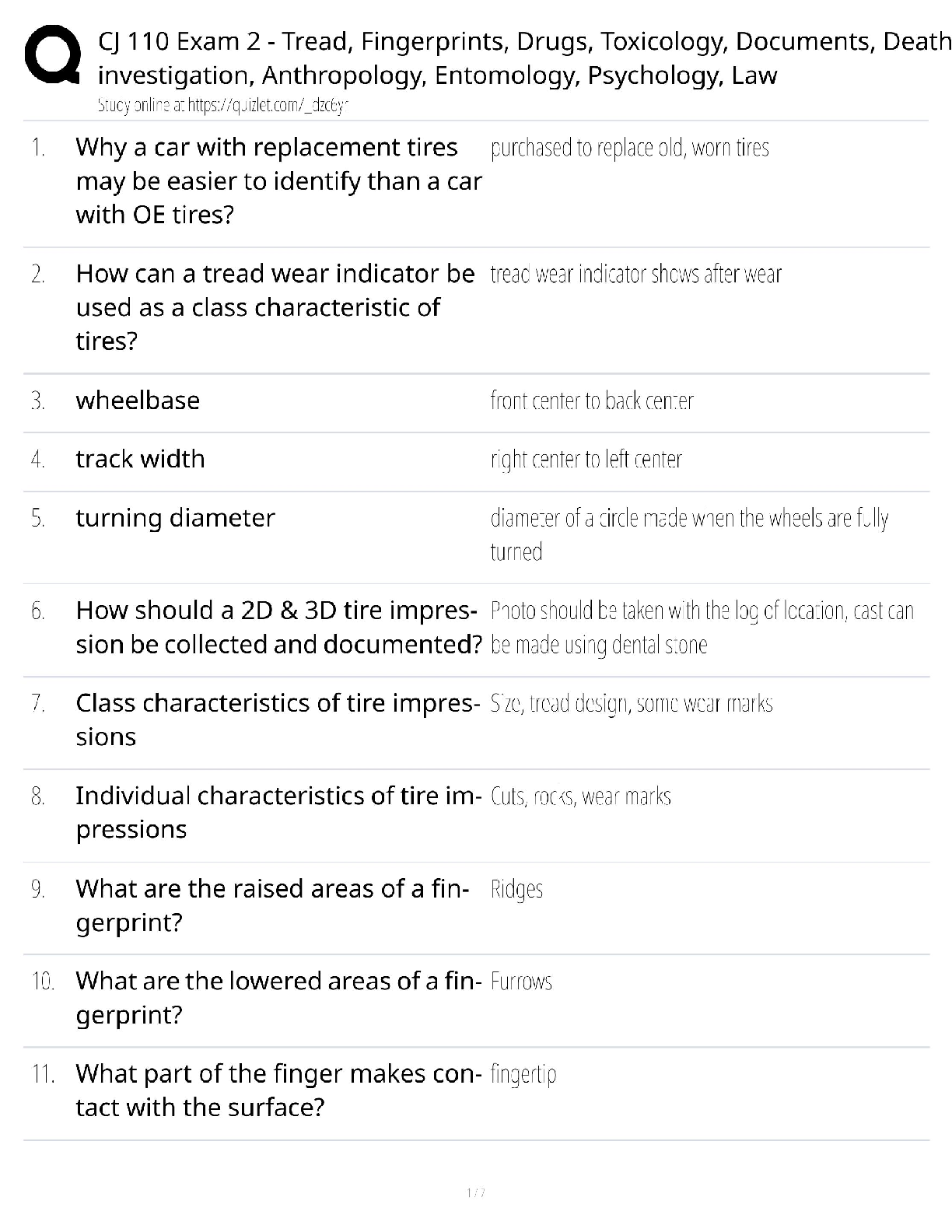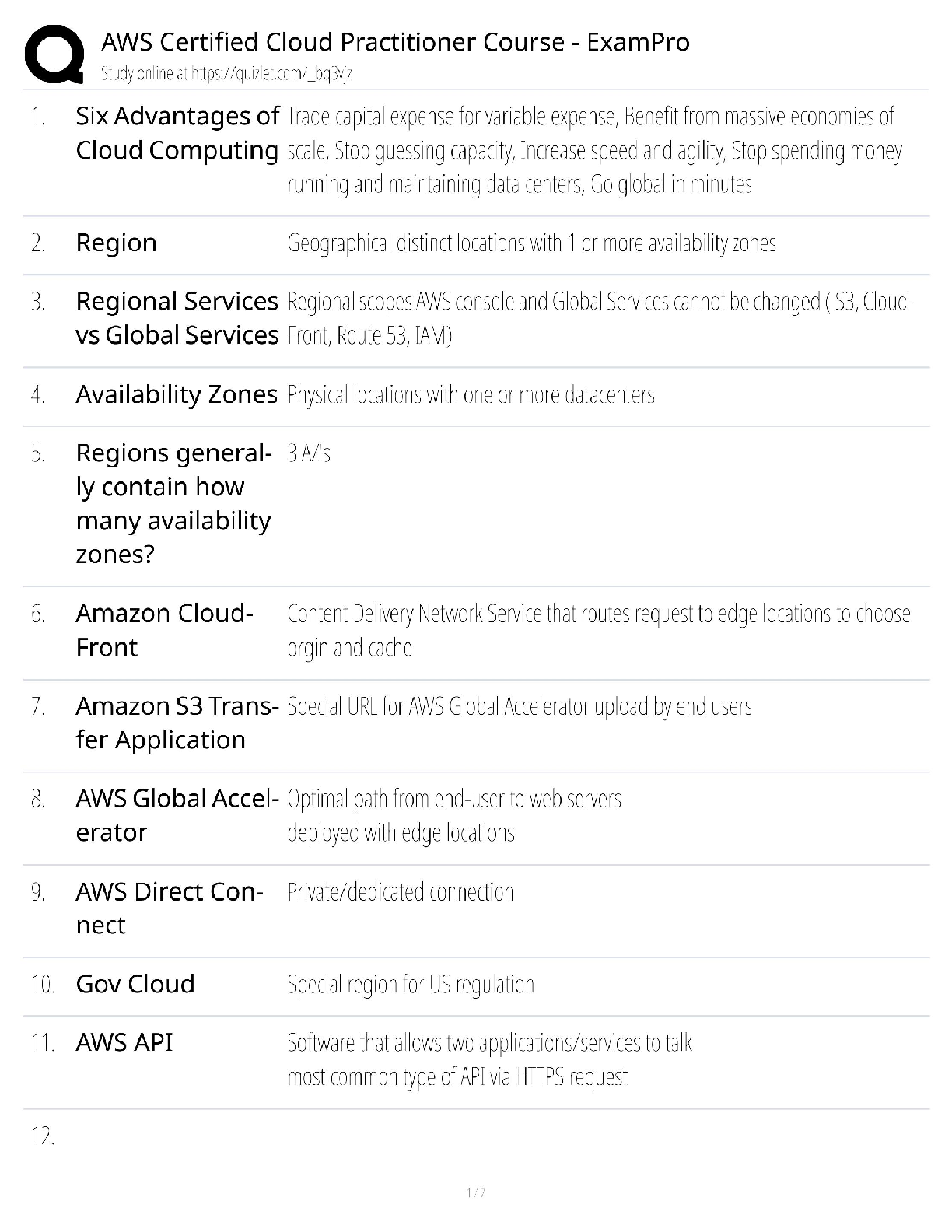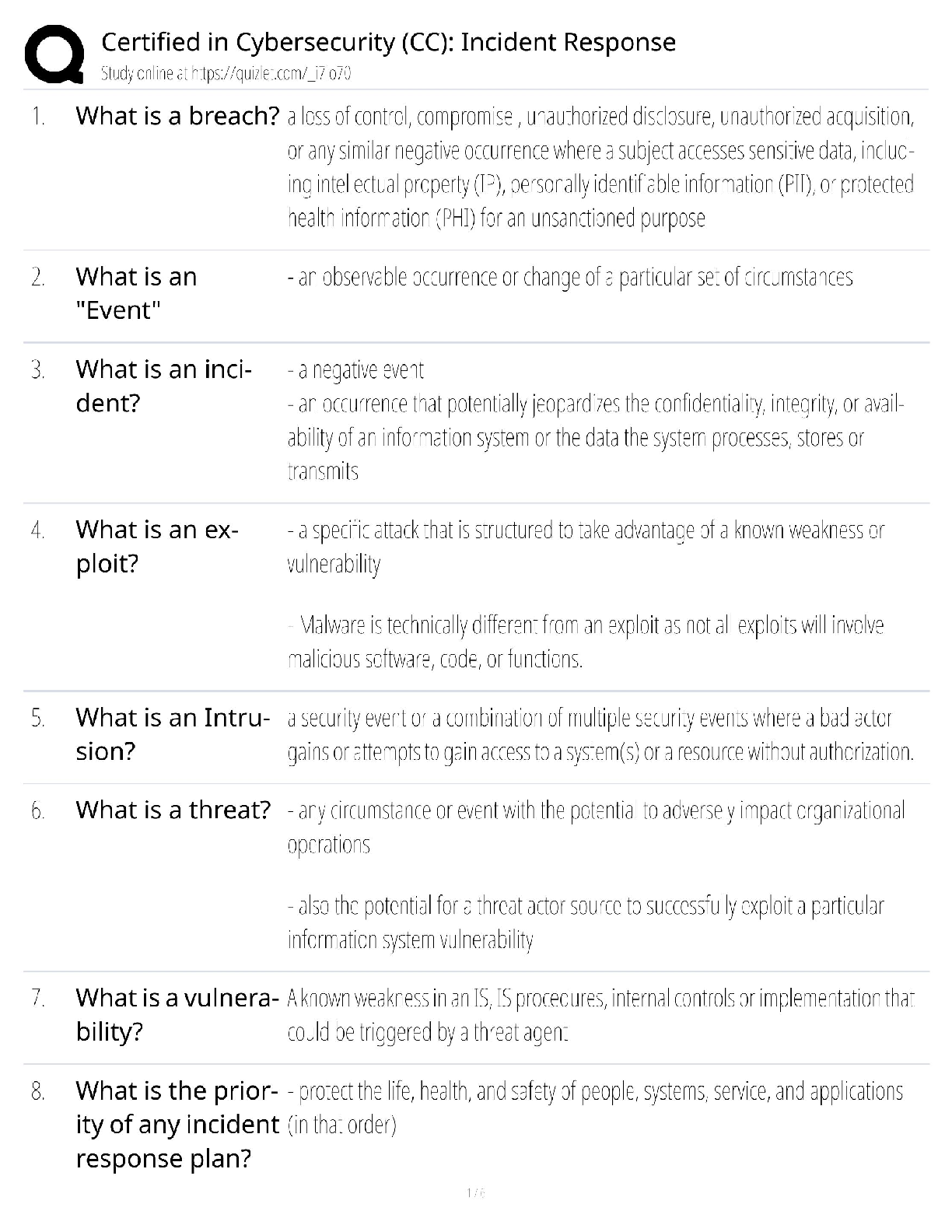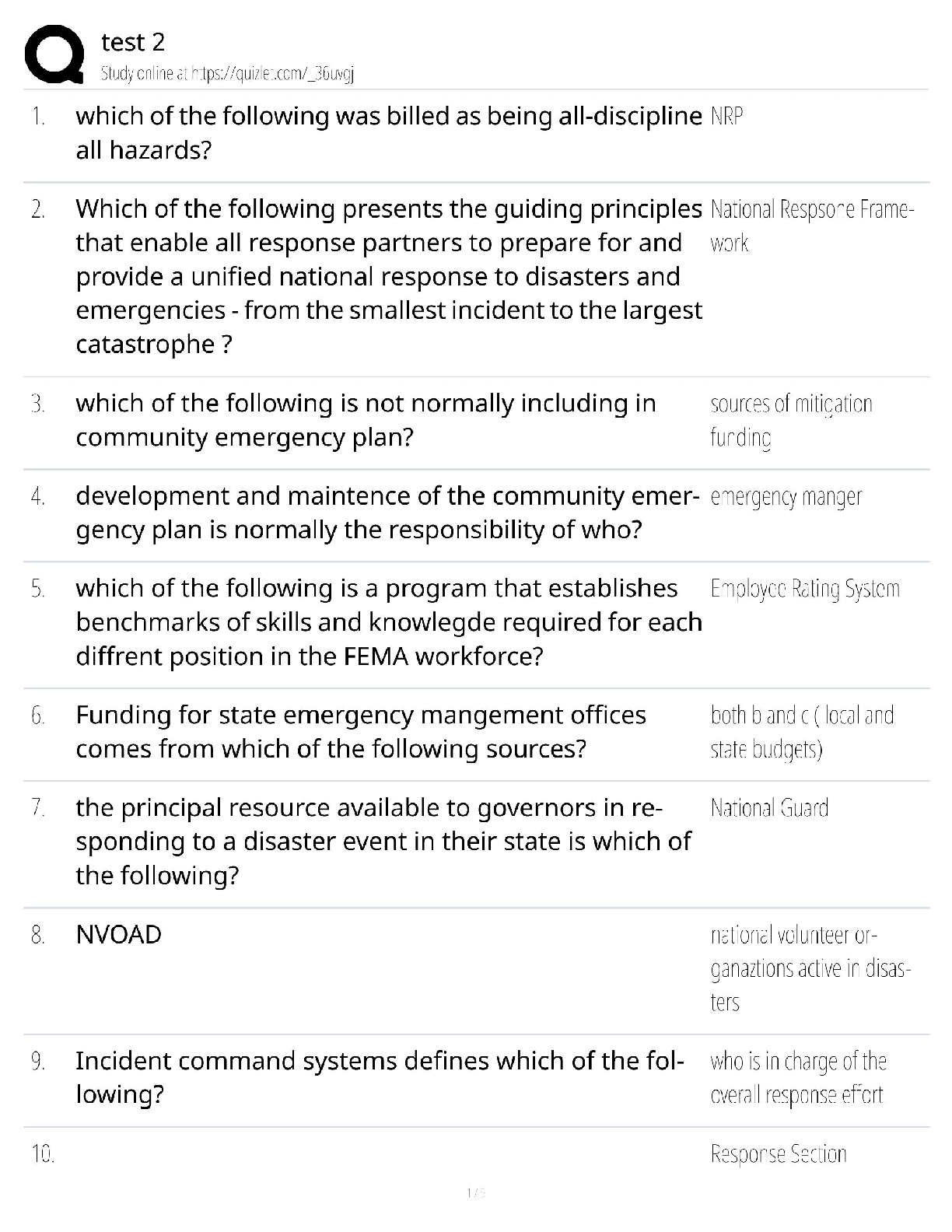Paediatrics > QUESTIONS & ANSWERS > PALS-Pretest Questions and Answers Graded A (All)
PALS-Pretest Questions and Answers Graded A
Document Content and Description Below
PALS-Pretest Questions and Answers Graded A Sinus tachycardia Sinus bradycardia Supraventricular tachycardia Asystole Wide-complex tachycardia Ventricular fibrillation with successful defibrill ... ation and resumption of organized rhythm Sinus bradycardia Pulseless electrical activity Torsades de pointes Ventricular fibrillation Wide-complex tachycardia SVT converting to sinus rhythm after adenosine administration Normal sinus In asystole, what is the effect of epi? stimulate spontaneous contractions Routine administration of calcium chloride (is/is not) indicated in pediatric patients during cardiac arrest is not A 9-year-old boy is agitated and leaning forward on the bed in obvious respiratory distress. The patient is speaking in short phrases and tells you that he has asthma but does not carry an inhaler. He has nasal flaring, severe suprasternal and intercostal retractions, and decreased air movement with prolonged expiratory time and wheezing. You administer 100% oxygen by a nonrebreathing mask. His SpO2 is 92%. What medication do you prepare to give to this patient? albuterol You are part of a team attempting to resuscitate a child with vfib cardiac arrest. You delivered 2 unsynchronized shocks. A team member established IO access, so you give a dose of epi, 0.01mg/kg IO. At the next rhythm check, persistent vfib is present. You administer a 4 J/kg shock and resume CPR. What should be administered next? amiodarone 5mg/kg IO What oxygen delivery system most reliably delivers a high (≥90%) concentration of inspired oxygen to a 7-year-old child? nonrebreathing face mask ET drug administration during resuscitative efforts for pediatric patients is the (least/most) desirable route of administration. least You are called to help treat an infant with severe symptomatic bradycardia (HR 66 bpm) associated with respiratory distress. The bradycardia persists despite establishment of an effective airway, oxygenation, and ventilation. There is no heart block present. What is the 1st drug you should administer? epi Paramedics are called to the home of a 1-year-old child. Their initial assessment reveals a child who responds only to painful stimuli and has irregular breathing, faint central pulses, bruises over the abdomen, abdominal distention, and cyanosis. Bag-mask ventilation with 100% oxygen is initiated. The child's HR is 36 bpm. Peripheral pulses cannot be palpated, and central pulses are barely palpable. The cardiac monitor shows sinus bradycardia. Two-rescuer CPR is started. Upon arrival to the ED, the child is intubated and ventilated with 100% oxygen, and IV access is established. The HR is now 150 bpm with weak central pulses but no distal pulses. SBP is 74 mmHg. What intervention should be provided next? rapid bolus of 20mL/kg of isotonic crystalloid A previously healthy infant with a history of vomiting and diarrhea is brought to the ED by her parents. During your assessment, you find that the infant only responds to painful stimulation. The infant's RR is 40 bpm, and central pulses are rapid and weak. The infant has good bilateral breath sounds, cool extremities, and a capillary refill time of >5 sec. The infant's BP is 86/65 mmHg, and glucose is 30mg/dL. You administer 100% oxygen via face mask and start in IV. What is the most appropriate treatment? bolus of isotonic crystalloid 20mL/kg over 5-20 min and D25W 2-4mL/kg IV Initial impression of a 2-year-old girl shows her to be alert with mild breathing difficulty during inspiration and pale skin color. On primary assessment, she makes high-pitched inspiratory sounds (mild stridor) when agitated; otherwise, her breathing is quiet. Her SpO2 is 92% on room air, and she has mild inspiratory intercostal retractions. Lung auscultation reveals transmitted upper airway sounds with adequate distal breath sounds bilaterally. What is the most appropriate initial intervention for this child? humidified oxygen as tolerated You are caring for a 3-year-old with vomiting and diarrhea. You have established IV access. The child's pulses are palpable, but faint, and the child is now lethargic. The HR is variable (range: 44-62 bpm). You begin bag-mask ventilation with 100% oxygen. When the HR does not improve, you begin chest compressions. The rhythm shown here is seen on the cardiac monitor. What would be the most appropriate therapy to consider next? transcutaneous pacing A 4-year-old boy is in pulseless arrest in the pediatric ICU. High-quality CPR is in progress. You quickly review his chart and find that this baseline-corrected QTI on a 12-lead EKG is prolonged. The monitor shows recurrent episodes of the rhythm shown here. The has received 1 dose of epi 0.01mg/kg, but the rhythm shown here continues. If this rhythm persists at the next rhythm check, what medication would be most appropriate to administer at that time? MgSO4 25-50 mg/kg IV You and another rescuer begin CPR. Your colleague begins compressions, and you notice that the compression rate is too low. What should you say to offer constructive feedback? 'You need to compress at a rate of 100-120/min' You are alone and witness a child suddenly collapse. There is no suspected head or neck injury. A colleague responded to your shout for help and is activating the emergency response system and is retrieving the resuscitation equipment, including a defibrillator. After delivering 30 compressions, what would be your next action? one the airway with a head tilt-chin lift maneuver and give 2 breaths An 18-month-old child has a 1-week history of cough and runny nose. The child has diffuse cyanosis and is responsive only to painful stimulation with slow respirations and rapid central pulses. The child's RR has decreased from 65 bpm to 10 bpm, severe inspiratory intercostal retractions are present, HR is 160 bpm, SpO2 is 65% on room air, and capillary refill is <2secs. What is the most appropriate immediate interventions for this toddler? open the airway and provide positive-pressure ventilation using 100% oxygen and a bag-mask device A child becomes unresponsive in the ED and is not breathing. You are uncertain if a faint pulse is present. You shout for help and provide ventilation with 100% oxygen. The rhythm shown here is seen on the cardiac monitor. What is your next action? start high-quality CPR During bag-mask ventilation, how should you hold the mask to make an effective seal between the child's face and mask? position your fingers using the E-C clamp technique How can rescuers ensure that they are providing effective breaths when using a bag-mask device? observing the chest rise with each breath You just assisted with the elective ET intubation of a child with respiratory failure and a perfusing rhythm. What method provides a reliable, prompt assessment of correct ET tube placement in this child? adequate bilateral breath sounds and chest expansion + detection of ETCO2 with waveform capnopgraphy What compression-to-ventilation ration should be used for 2-rescuer infant CPR? 15 compressions to 2 breaths You find a 10-year-old boy to be unresponsive. You shout for help, and after finding that he is not breathing and has no pulse, you and a colleague begin CPR. Another colleague activates the emergency response system, brings the emergency equipment, and places the child on a cardiac monitor/defibrillator, which reveals the rhythm shown here. You attempt defibrillation at 2 J/kg and give 2 minutes of CPR. The rhythm persists at the second rhythm check, at which point you attempt defibrillation with 4 J/kg. A 4th colleague arrives, starts an IV, and administers 1 dose of epi 0.01mg/kg. If vfib or pulseless ventricular tachycardia persists after 2 minutes of CPR, you will administer another shock. What drug and dose should be administered next? lidocaine 1mg/kg You are preparing to use a manual defibrillator in the pediatric setting. What best describes when it is appropriate to use the smaller, pediatric-sized paddles? if the child weighs <10kg or <1 year old You are evaluating an irritable 6-year-old girl with mottled skin color. The patient is febrile (T 40°C/104°F), and her extremities are cold with capillary refill of 5 secs. Distal pulses are absent and central pulses are weak. HR is 180 bpm, RR is 45 bpm, and BP is 98/56 mmHg. How would you categorize this child's condition? compensated shock associated with tachycardia and inadequate tissue perfusion You are supervising a student when is inserting an IO needle into an infant's tibia. The student asks you what she should look for to know that she has successfully inserted the needle into the bone marrow cavity. What do you tell her? 'Fluids can be administered freely without local soft tissue swelling.' An 8-month-old infant is brought to the ED for evaluation of severe diarrhea and dehydration. On arrival to the ED, the infant becomes unresponsive, apneic, and pulseless. You should for help and start CPR. Another provider arrives, at which point you switch to 2-rescuer CPR. The rhythm shown here is seen on the cardiac monitor. The infant is intubated and ventilated with 100% oxygen. An IO line is established, and a dose of epi is given. While continuing highquality CPR, what do you do next? give NS 20mL/kg IO rapidly You need to provide rescue breaths to a child victim with a pulse. What is the appropriate rate for delivering breaths? 1 breath q3-5 secs What ratio of compressions to breaths should be used for 1-rescuer child CPR? 30 compressions to 2 breaths A pale and very sleepy but arousable 3-year-old child with a history of diarrhea is brought to the hospital. Primary assessment reveals a RR of 45 bpm with good breath sounds bilaterally. HR is 150 bpm, BP is 90/64 mmHg, and SpO2 is 92% on room air. Capillary refill is 5 secs and peripheral pulses are weak. After placing the child on a nonrebreathing face mask (10-L/min flow) with 100% oxygen and obtaining vascular access, what is the most appropriate immediate treatment for this child? bolus of 20mL/kg isotonic crystalloid A 7-year-old boy is found unresponsive, apneic, and pulseless. CPR is ongoing. The child is intubated, and vascular access is established. The EKG monitor shows an organized rhythm with a HR of 45 bpm, but a pulse check reveals no palpable pulse. High-quality CPR is resumed, and an initial IV dose of epi is administered. What intervention should you perform next? identify and treat reversible causes You are caring for a 6-year-old patient who is receiving positive-pressure mechanical ventilation via an ET tube. The child begins to move his head and suddenly becomes cyanotic, and his HR decreases. His SpO2 is 65%. You remove the child from the mechanical ventilator and begin to provide manual ventilation with a bag via the ET tube. During manual ventilation with 100% oxygen, the child's color and HR improve slightly but his BP remains inadequate. Breath sounds and chest expansion are present and adequate on the R side and are present but consistently diminished on the L side. The trachea is not deviated, and the neck veins are not distended. A suction catheter passes easily beyond the tip of the ET tube. What is the most likely cause of this child's acute deterioration? tracheal tube displacement into the R main bronchus A 1-year-old boy is brought to the ED for evaluation of poor feeding, irritability, and sweating. The child is lethargic but arousable. He has labored breathing, very rapid pulses, and a dusky color. His RR is 68 bpm, HR 300 bpm, and BP 70/45 mmHg. He has weak brachial pulses and absent radial pulses, a capillary refill of 6 secs, SpO2 85% on room air, and good bilateral breath sounds. You administer high-flow oxygen and place the child on a cardiac monitor and see the rhythm shown here. The child has no history of congenital heart disease. IV access has been established. What therapy is most appropriate for this child? adenosine 0.1mg/kg IV rapid push A 3-year-old boy presents with multiple-system trauma. The child was an unrestrained passenger in a high-speed MVC. On primary assessment, he is unresponsive to voice or painful stimulation. His RR is 5 bpm, HR and pulses are 170 bpm, SBP is 60 mmHg, capillary refill is 5 secs, and SpO2 is 75% on room air. What action should you take first? while a colleague provides spinal motion restriction, open the airway with a jaw thrust and provide bag-mask ventilation Why is allowing complete chest recoil important when performing high-quality CPR? the heart will refill with blood between compressions An 8-year-old child was struck by a car. He arrives in the ED alert, anxious, and in respiratory distress. His cervical spine is immobilized, and he is receiving 10-L/min flow of 100% oxygen by nonrebreathing face mask. His RR is 60 bpm, HR 150 bpm, SBP 70 mmHg, and SpO2 84%. Breath sounds are absent over the R chest but present over the L chest, and the trachea is deviated to the L. He has weak central pulses and absent distal pulses. What intervention should be perfomed next? needle decompression of the R chest You find an infant who is unresponsive, is not breathing, and does not have a pulse. You shout for nearby help, but no one arrives. What action should you take next? Provide CPR for ~2 mins before leaving to activate the emergency response system You are giving chest compressions for a child in cardiac arrest. What is the proper depth of compressions for a child? compress the chest to at least 1/3 the depth of the chest, ~2 in/5 cm You are assisting in the elective intubation of an average-sized 4-year-old child with respiratory failure. A colleague is retrieving the color-coded length-based tape from the resuscitation cart. What is likely to be the estimated size of the uncuffed ET tube for this child? 5mm tube A 10-month-old infant is brought to the ED. your initial assessment reveals a lethargic, pale infant with slow respirations and slow, weak central pulses. One team member begins ventilation with a bag-mask device with 100% oxygen. A 2nd team member attaches the monitor/defibrillator and obtains VS while a 3rd team member attempts to establish IV/IO access. The patient's HR is 38 bpm with the rhythm shown here. The infant's BP is 58/38 mmHg, and the capillary refill is 4 secs. His central pulses remain weak, and distal pulses cannot be palpated. Chest compressions are started and IO access is obtained. What medication do you anticipate will be given next? epi 0.01mg/kg IO A 3-year-old unresponsive, apneic child is brought to the ED. EMS personnel report that the child became unresponsive as they arrived at the hospital. The child is receiving CPR with bagmask ventilation. The rhythm shown here is on the cardiac monitor. A biphasic manual defibrillator is present. You quickly use the length from head to hell of the child on a color-coded length-based resuscitation tape to estimate the approximate weight as 15kg. What therapy is most appropriate for this child at this time? attempt defibrillation at 30J, and then resume CPR, beginning with compressions [Show More]
Last updated: 2 years ago
Preview 1 out of 14 pages
.png)
Buy this document to get the full access instantly
Instant Download Access after purchase
Buy NowInstant download
We Accept:

Also available in bundle (1)
Click Below to Access Bundle(s)
.png)
PALS BUNDLED EXAMS QUESTIONS AND ANSWERS ALREADY PASSED
PALS BUNDLED EXAMS QUESTIONS AND ANSWERS ALREADY PASSED
By Nutmegs 2 years ago
$27
25
Reviews( 0 )
$10.00
Can't find what you want? Try our AI powered Search
Document information
Connected school, study & course
About the document
Uploaded On
Jan 30, 2023
Number of pages
14
Written in
All
Additional information
This document has been written for:
Uploaded
Jan 30, 2023
Downloads
0
Views
182





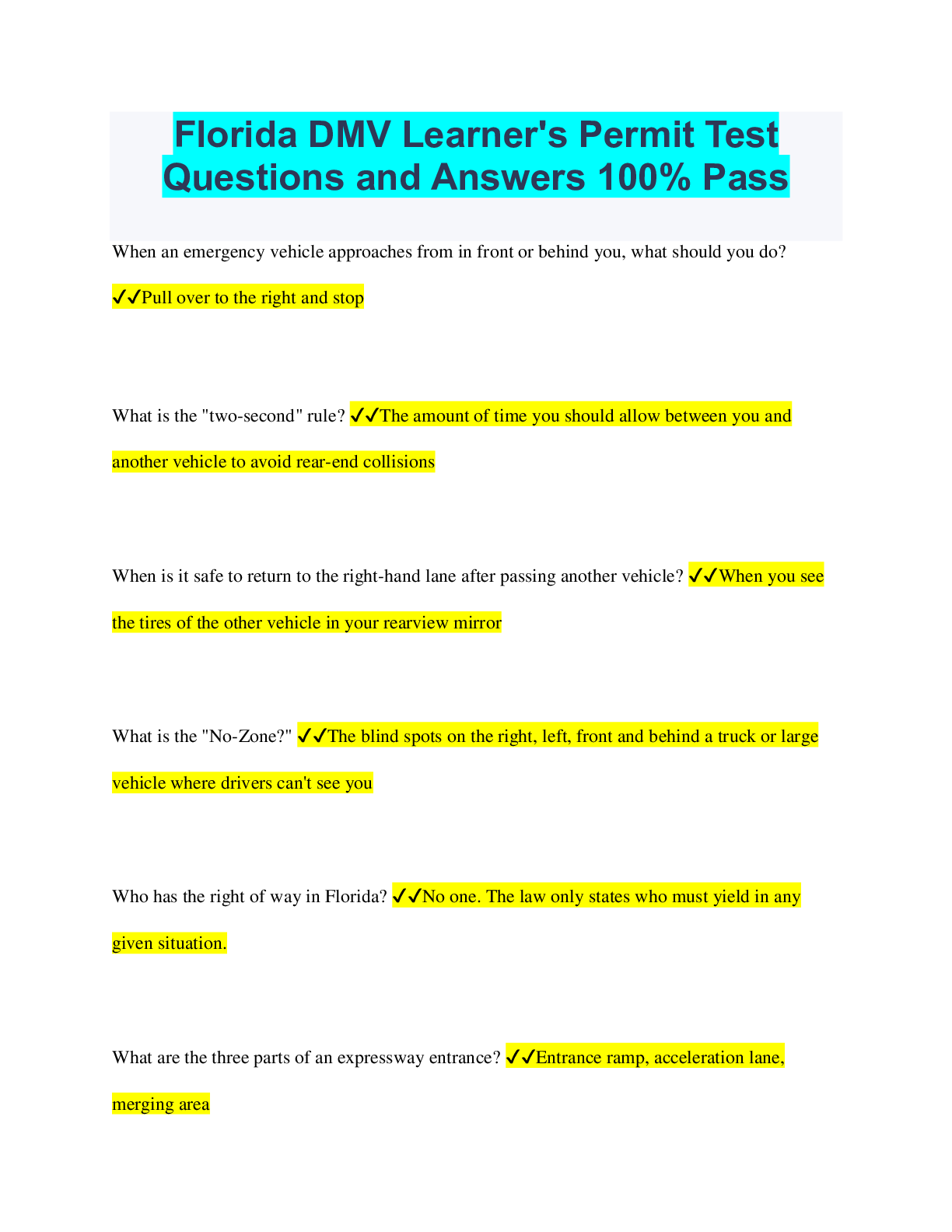
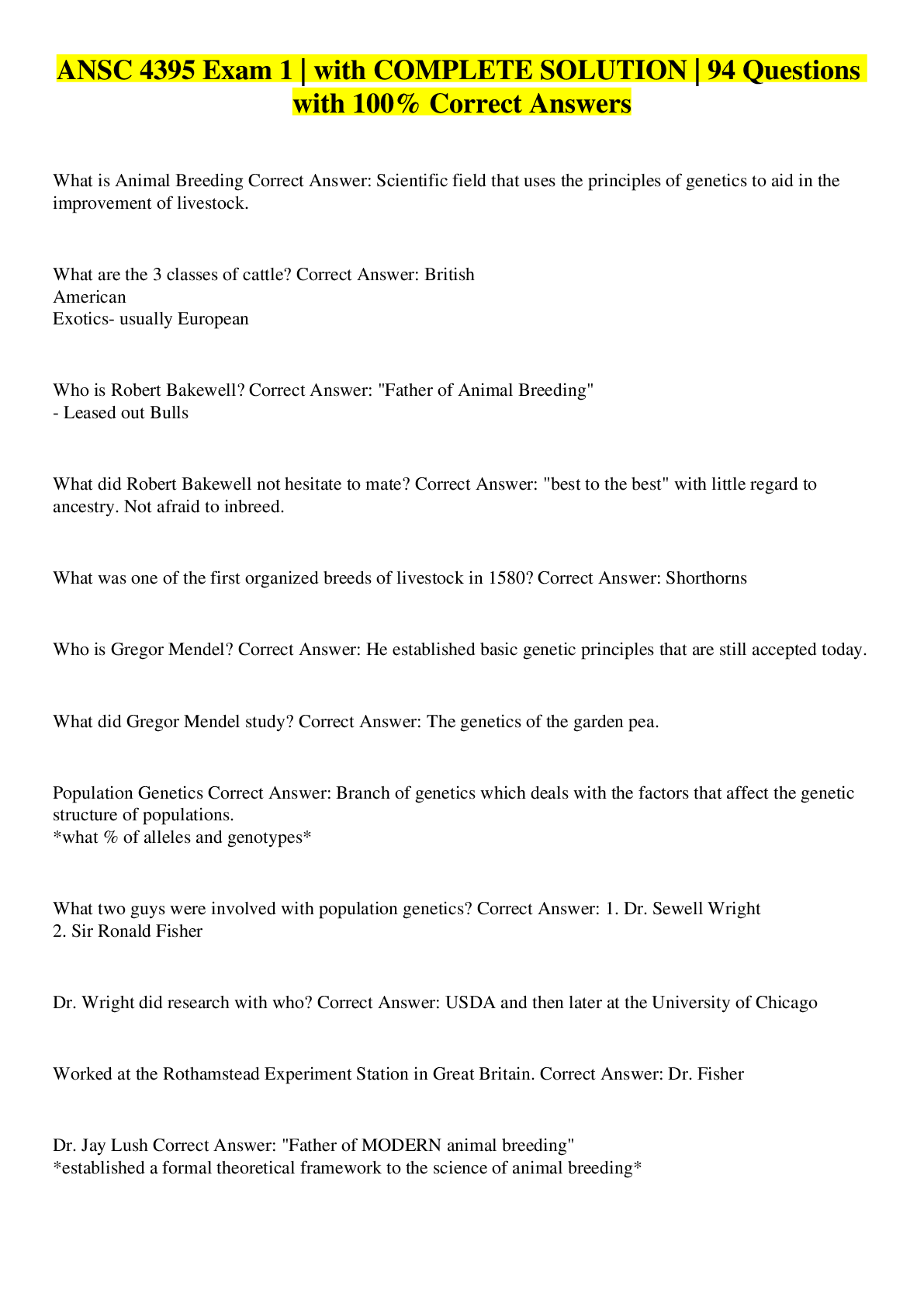

.png)




